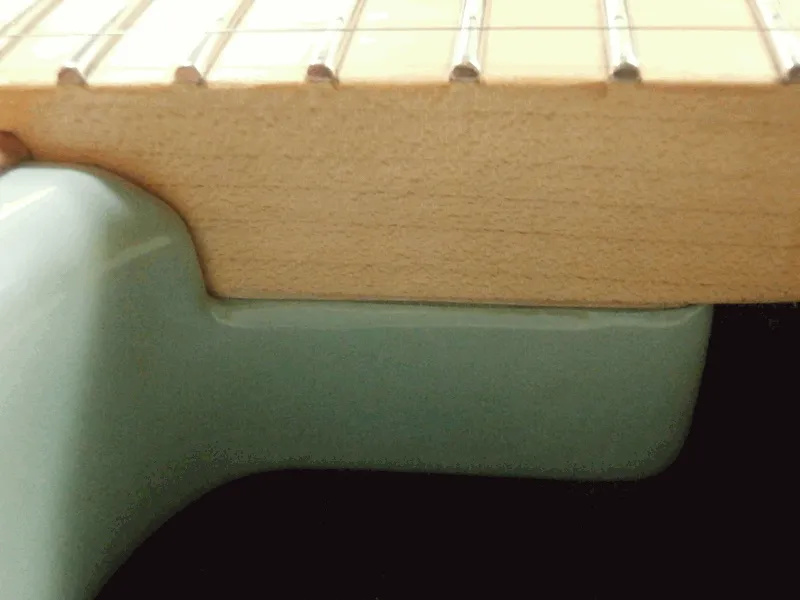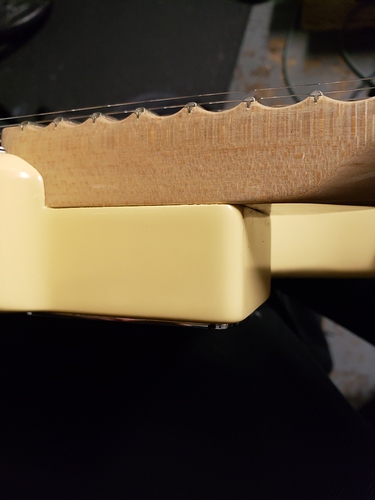I do agree, my ODCs wont let me shim a guitar.
I spoke with Callaham and they dont carry longer saddle screws, and they dont recommend going that route., that something sounds wrong with the setup…
Granted they dont know anything about this guitar…
Not sure where to go at this point…
I like the guitar as is, but wouldn’t mind raising it more…
???
Honestly that doesn’t surprise me. And they’re not wrong, we know something is wrong with the neck angle, because that SHOULDN’T be the case on a Strat, that a maxed out saddle height is too low for normal action on a Strat.
How thick is your current shim? Again, unless it’s already extremely aggressively shimmed, an increase in the thickness of the shim at the leading edge of the neck pocket would take some angle out of the neck and allow you to get higher action at the bridge, and within normal limits there is absolutely nothing wrong or dangerous to the guitar about shimming a bolt-on neck.
If it IS pretty aggressively shimmed already, then simply returning the guitar for a defective neck angle might be your best bet. A picture of the side of the neck pocket showing the thickness of the shim and how much angle is being added would probably help here.
Thanks,
I’m going to defer to twangsta here, but the action is set for " normal " play. The idea here is to set the guitar up with higher action per the yngwie preference. The stock saddle screws cant accommodate this.
The tech took the neck off really quick and there was a modest shim on the side facing toward the headstock.
Guitar plays and sounds fine, just wanted to go higher without maxing out the saddle screws…
Can you take a picture of the shimmed neck pocket?
I’m not a Yngwie specialist by any means, but I’ve been doing tech work on my own guitars and my buddies’ guitars for the better part of two decades, and I’m very comfortable and familiar with working on Strats. The normal problem here is getting action DOWN to 1.5mm, not up to it, and if it’s a “modest” shim, then increasing the shim thickness anywhere from half again to double the current thickness ought to solve this problem just fine.
Your saddle screws are totally maxed out - that’s absolutely not right, and Callaham is right, this is the product of some sort of a setup issue, and from the sound of it almost certainly too much neck angle.
Thanks but I’m not that comfortable removing the neck… again will defer to twangsta, …

@Drew this YJM sig guitar is all about extremes. As they say “perfection is reached at the point of collapse”. As in my pictures, my saddles have been on the edge for two years, and I play hard everyday. My does’nt go out of tune, hell it’s more stable than some of the fixed bridge guitars I’ve owned for years.
@NCASO
I forgot to mention a detail; in my setup my neck truss rod if I remember correctly is almost fully loose; just enough tension to keep the nut from developing a rattle. Having extra relief I feel will get you all the way, if your neck will give.
Honestly I’ve had expensive boutique guitars that didn’t have enough relief with the nut entirely loose! Grosh was an example; horrible neck to setup, and it was a custom build. My Lentz was done well cause I made it clear to Scott that this is a critical requirement of mine. The neck must have enough of a natural relief.
My YJM just about manages to get into that Goldilocks zone for me. Again, just. The truss rod nut is less than a quarter turn from coming loose.
edit: also here’s another tip: I use the neck relief to compensate for humidity changes; always have on all my guitars, don’t have to muck each saddle/intonation etc. just the truss rod. Quarter turn at at time; can’t go wrong. Sometimes give it a few mins between turns to settle. You’ll eventually get to know that each guitar is different, a good guitar like the YJM should respond instantly.
The only time I need to adjust the bridge etc; are when I change sting gauges or something shifts for some reason, like my high e saddle; or my preferences change!
I guess what I’m trying to say is that the truss rod adjustment is like a trim control like fixed wing aeroplanes have.
The tech did adjust for relief…honestly the guitar feels and sounds great to me.
Totally different feel from the first go around…
The malmsteen strings are fantastic, I never thought they would make that much of a difference
The setup , the Callaham bridge, the clean boost…
Glad to hear that man, it’s a beast; doesn’t that 8 just scream under high gain, more than a 9 would! You will be annoyed as to how long thos strings last; I change mine out out of spite; or worry about the rest of my backup sets rusting! Somehow they last longer while being used! The string gauge spread is unique to him, other 9/46 follow a different path.
setup … check
bridge… check
clean boost … check
your on your way man, the articulation you’ll get from this guitar is what really … what you put in is what you get!
Enjoy and play loud 
fender should give me a commission on this one 
270 posts!
I was so fearful that the high e was going to be thin and weak, but it screams!
Plus that brass claw is coming!
I have a lot of practicing ahead of me
the high e thing was a revelation to me too, had no idea, so unintuitive but the master knows 
Yeah, I mean, that’s the purpose of a truss rod, to adjust the amount of relief as the wood shifts due to either humidity or string tension.
I’m not sure how much relief you’re looking for, but ideally you don’t need much - the string vibrates in a path that sort of widens as you go along so you need a little bit of relief to adjust for that, but maybe the thickness of a business card or so, and the more relief you have in the neck, the higher the action is going to be in the middle of the neck, relative to towards the nut or towards the bridge. If that’s something you like in a setup, there’s absolutely a subjective component to this, but generally guitarists like action to be pretty consistent from fret to fret, in my experience.
Just keep in mind that your guitar and twangsta’s guitar may be the same model, but they’re separate instruments and have idiosyncratic quirks that the other doesn’t. Yours seems to, by default, have more neck angle than his due, either due to a slightly different cut to the neck pocket or the neck joint, so if he’s not shimming the neck and getting 2-2.5mm action and you have to max your saddles out to get action to 1.25mm even with a shim to take down the neck angle, then you’re pretty clearly starting from a different point than he is, and you’re going to need a different approach to get to the same spot.
If you’re not comfortable doing the work yourself, then take it to your tech, but if you have the saddles totally maxed out at the bridge and you’re only getting action to 1.25mm, then you have too little neck angle. If there’s only a very slight shim in the neck now then increasing the angle will do you a lot of good, but if the neck is already pretty heavily shimmed, then the guitar itself may be defective and you might be better off returning it rather than trying to make it work.
Again, though, a picture of the joint between the neck and neck pocket would be really helpful here, in trying to get a sense for how far the neck is already shimmed. 
For what its worth, when the tech took the neck off, he recommended a .5 shim…
I’m going to bring it back next week and have him do it…
Maybe I’ll work up enough nerve myself to take a picture and send it beforehand
Yeah, a shim is the most likely fix here.
And sorry if I wasn’t clear - don’t take the neck off, just a picture of the joint between the two while they’re still connected, like this:
…just maybe a little more head-on from the side, and not at so much of an angle.
Also guys; one obvious advantage of machine bolts are you can safely disassemble the neck as many times you need to.
But as Drew says a picture of the neck as he’s posted will give us an idea of where your at.
Also if your are shimming more than what it’s already at; make sure the luthier aborts if theres significantly more resistance when tightening the bolts.
edit: But I think it’s a pain to remove the neck as the stings come undone, unless you use a faster around the neck; even then not the best thing cause one thing I’ve notice with this guitar, lifting it up by the neck can kink the strings due to the scallops. probably doesn’t mater but something I would watch for.
Yeah - if I ever strip out the neck on my (now 21-year-old, and has had it’s neck off a whole BUNCH of times over the years) main Strat, I’m having that mod done for that exact reason. I don’t think it makes enough difference to bother with before, and I’d probably try the tooth pick and wood glue thing first in a pinch if it was just a single screw, but it seems a more secure repair than drilling it out and inserting a wooden dowel, IMO.
But, Twangsta’s right - if you’re not comfortable doing it yourself then by all means don’t, but it’s extremely hard to strip a metal-on-metal connection if both metals are the same material. 
Thank you for clarifying, I’ll send some pic later.
Btw, can I tell you both that you are both great for helping me out?
If you’re ever in SE PA, let me know and I’ll let you work on my guitars for FREE!!!
jk, I’ll buy u both lunch
 No problem man, always happy to help!
No problem man, always happy to help!


